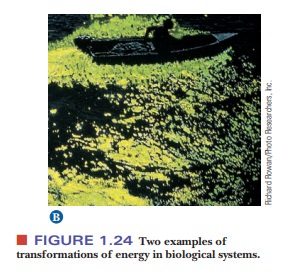Chapter: Biochemistry: Biochemistry and the Organization of Cells
Energy and Change: What kinds of energy changes take place in living cells?
Energy and Change
What kinds of energy changes take place in living cells?
Energy
can take several forms, and it can be converted from one form to another. All
living organisms require and use energy in varied forms; for example, motion
involves mechanical energy, and maintenance of body temperature uses thermal
energy. Photosynthesis requires light energy from the Sun. Some organisms, such
as several species of fish, are striking examples of the use of chemical energy
to produce electrical energy (Figure 1.24). The formation and breakdown of
biomolecules involve changes in chemical energy.

Any process that will actually take place with no outside intervention is spontaneous in the specialized sense used in thermodynamics. Spontaneousdoes not mean “fast”; some spontaneous processes can take a long time to occur.
The laws
of thermodynamics can be used to predict whether any change involving
transformations of energy will take place. An example of such a change is a
chemical reaction in which covalent bonds are broken and new ones are formed.
Another example is the formation of noncovalent interac-tions, such as hydrogen
bonds, or hydrophobic interactions, when proteins fold to produce their
characteristic three-dimensional structures. The tendency of polar and nonpolar
substances to exist in separate phases is a reflection of the energies of
interaction between the individual molecules-in other words, a reflection of
the thermodynamics of the interaction.
Summary
A
spontaneous reaction is one that will take place without outside inter-vention.
This point does not specify reaction rate. Some spontaneous processes can take
a long time to occur.
Related Topics